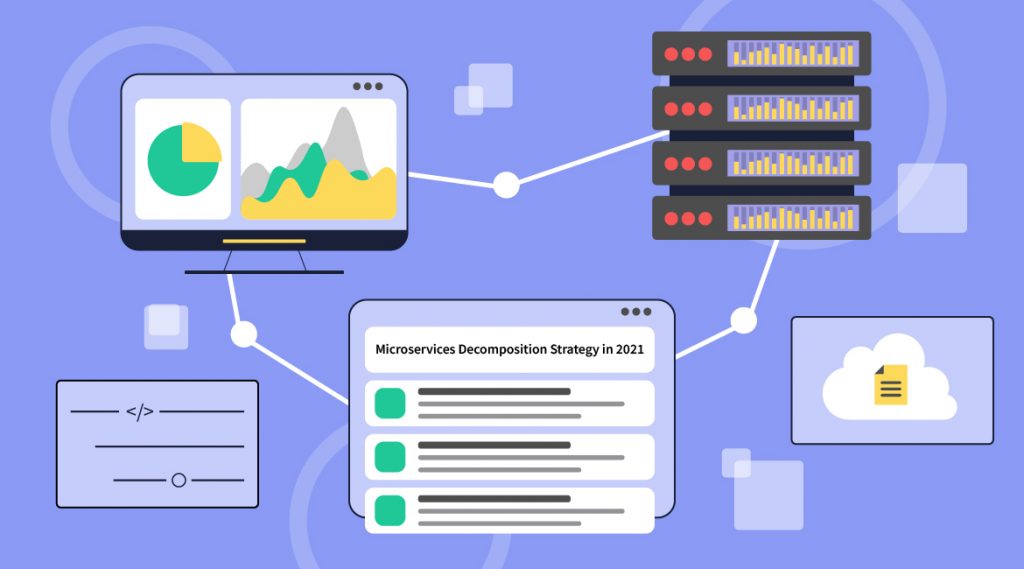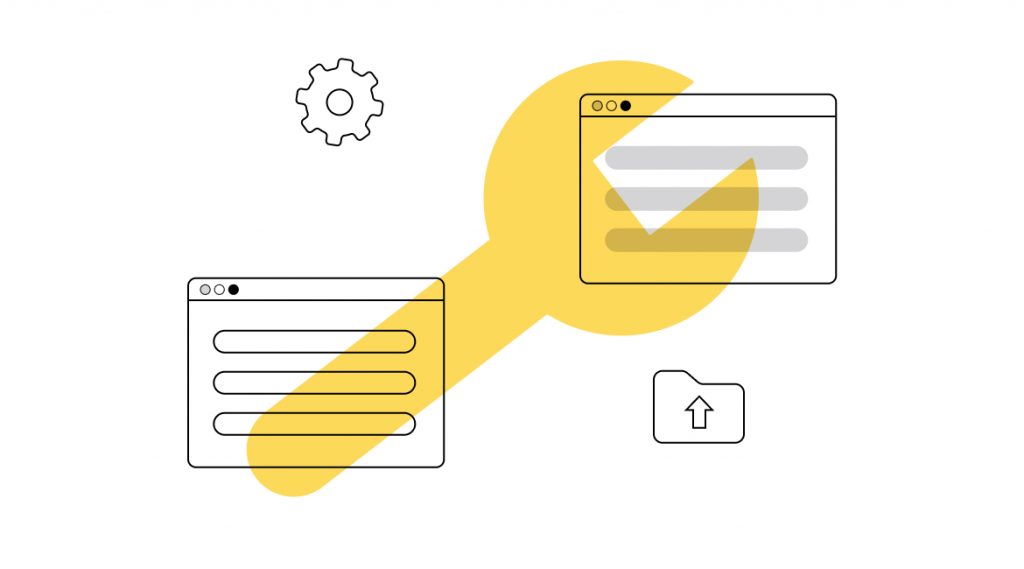Contents
Microservices decomposition strategy is becoming more and more popular these days. This approach offers more advantages over monoliths such as increased scalability, flexibility, and others. Many technology leaders have used legacy application modernization services and moved from monoliths to microservices.
As you know, the monolithic approach is standard in application development, but it entails a number of problems associated with processing a large codebase, scaling, etc. Today we will share with you our experience in DevOps, and talk about strategies for decomposing a monolithic architecture into microservices.
How to split a Monolith System into Microservices?

Let’s start with talking about decomposition methods.
Splitting the application into services
Decomposing an application into services is a key issue in the deployment and CI/CD architecture of microservices.
There is no single best decomposing strategy, but there are general methods to help you decompose your solution into multiple services.
- Divide by module. This method suggests isolating a component for each module or function and assigning them to separate teams that will be responsible for them.
- Split by domain. This method involves defining the region where your solution will be deployed. Each domain consists of several subdomains and each of them is responsible for a separate part of the business.
Discovery and registration of microservices
Microservices use the registry to store locations and send requests that can be managed on both the client and service sides. Each service must register at boot to verify its health. The health check interfaces also check the availability of the service.
Communication with microservices
Here are some ways to define the relationship between microservices.
- A remote process call abstracts the underlying data. When an application needs to replace data, it makes the replacement by referring to another application. In addition, each service can modify internal data without interfering with other applications.
- Domain-specific calling for cross-service calls for email or media streaming.
Microservices database management
Microservices must have persistent data in the database. There are several ways to manage databases.
- Database for individual services. Keep the data of each individual service private and accessible only through the API.
- Shared database. Use a single database for multiple services where they can access data from other services.
- Hybrid database. Create a single database and a separate one for specific services.
Microservices frontend
The frontend is the point of user interaction with the application. To provide a single entry point for all requests, implement an API gateway that will serve as a router to the real services.
This gateway provides endpoint security, protects application data, and limits requests to prevent DDoS attacks.
Microservices testing
When testing an application, you can:
- deploy all applications and run tests that include all components. This method will validate the use cases and ensure the quality of use. The disadvantages of this method are the length of the process and difficulty debugging.
- simulate other services and run unit tests. This will save a lot of time, but this method does not guarantee complete production safety.
CI/CD strategies
Each service is deployed as a set of instances for availability and throughput.
- You can run multiple services at the same time. This method will work if your application is still being developed or not used by a large number of people. But as the number of users grows, this method will bring problems such as resource conflicts, etc.
- A service instance on each node can help eliminate load balancing issues.
- The serverless deployment will allow you to archive your package and charge for it upon request. This method saves you from managing loads and resources.
Hire a team of DevOps engineers with IT Outposts
Contact UsTypes of Monoliths
Basically, there are two types of monoliths: single process and modular.
A single process monolith means deploying application code as a single process. This approach is popular in application development.
A modular monolith means dividing a long process into several modules that can exist independently of each other. Each Module has its own interface and can communicate with other modules. Despite the fact that all modules use a single database, they still need to be combined into one file for deployment.
When comparing Monolith vs Microservices, a modular monolith architecture offers a middle ground by dividing processes into independent modules with their own interfaces, allowing for streamlined communication within a single deployment file while utilizing a shared database.
Deploying a First Microservice from a Monolith

There are two ways to make the transition. Either maintaining a solid base of monolithic applications and starting to build microservices from it or gradually transforming applications into microservices.
In any case, teams need to define the boundaries of each microservice. To do this, teams should minimize the dependencies of the created microservices on monolithic applications, organize the exchange of information between services bypassing applications, and use a new environment in which applications are decomposed into components.
In such conditions, they can allocate a bound context for individual microservices and their databases, start and stop basic operations (CRUD) for each microservice, forming its autonomy. In this case, there is no need to share data between databases of several microservices to maintain stable performance.
To complete the formation of each microservice, you need the following:
- storing personal data for each microservice;
- reducing the number of dependencies between microservices;
- avoid distributed transactions;
- preference for asynchronous communication over synchronous;
- event-driven system (preferred).
After the microservice API is created, information exchange with the original monolithic application can be carried out only through it. This will prepare the service for complete autonomy from the application. After that, the service becomes isolated. Teams can repeat these steps until all services are disconnected from the monolithic application.
Deploying services in this manner enhances the organization’s ability to provide the functionality to multiple devices and applications. Companies can also provide endless development of their services by differentiating between existing and new modules.
Leading companies are already taking advantage of microservices. Wix.com moved away from the monolithic application that used to control all of its processes in favor of microservices and a new corporate culture, increasing scalability and quality of service.
Microservices are focused on increasing the speed of application development from concept to deployment. The architecture of the system is rigidly tied to the development process, organization of the company, and its culture.
Microservices can be thought of as an evolutionary component of a company’s growth that each element interacts with. Microservices emerged not only as an IT solution but also as a response to the demands of the modern market. They are a winning option for business leaders looking to align their IT infrastructure with the core business goals, no matter what the future holds.
Strategies for Decomposing Monolith to Microservices: Conclusion
Contrary to all beliefs, microservices are not a one-size-fits-all approach. Although monolithic programming is becoming less and less popular, it has strong and durable benefits that are better suited for many use cases.
Microservices are more beneficial for developing applications. They offer efficient solutions for dealing with a complex system of various functions and services in one application. Microservices are ideal when it comes to platforms that span multiple user paths and workflows. But without proper experience with microservices, this model would not be possible.
If you have any further questions regarding microservices decomposition strategy feel free to contact us.

I am an IT professional with over 10 years of experience. My career trajectory is closely tied to strategic business development, sales expansion, and the structuring of marketing strategies.
Throughout my journey, I have successfully executed and applied numerous strategic approaches that have driven business growth and fortified competitive positions. An integral part of my experience lies in effective business process management, which, in turn, facilitated the adept coordination of cross-functional teams and the attainment of remarkable outcomes.
I take pride in my contributions to the IT sector’s advancement and look forward to exchanging experiences and ideas with professionals who share my passion for innovation and success.